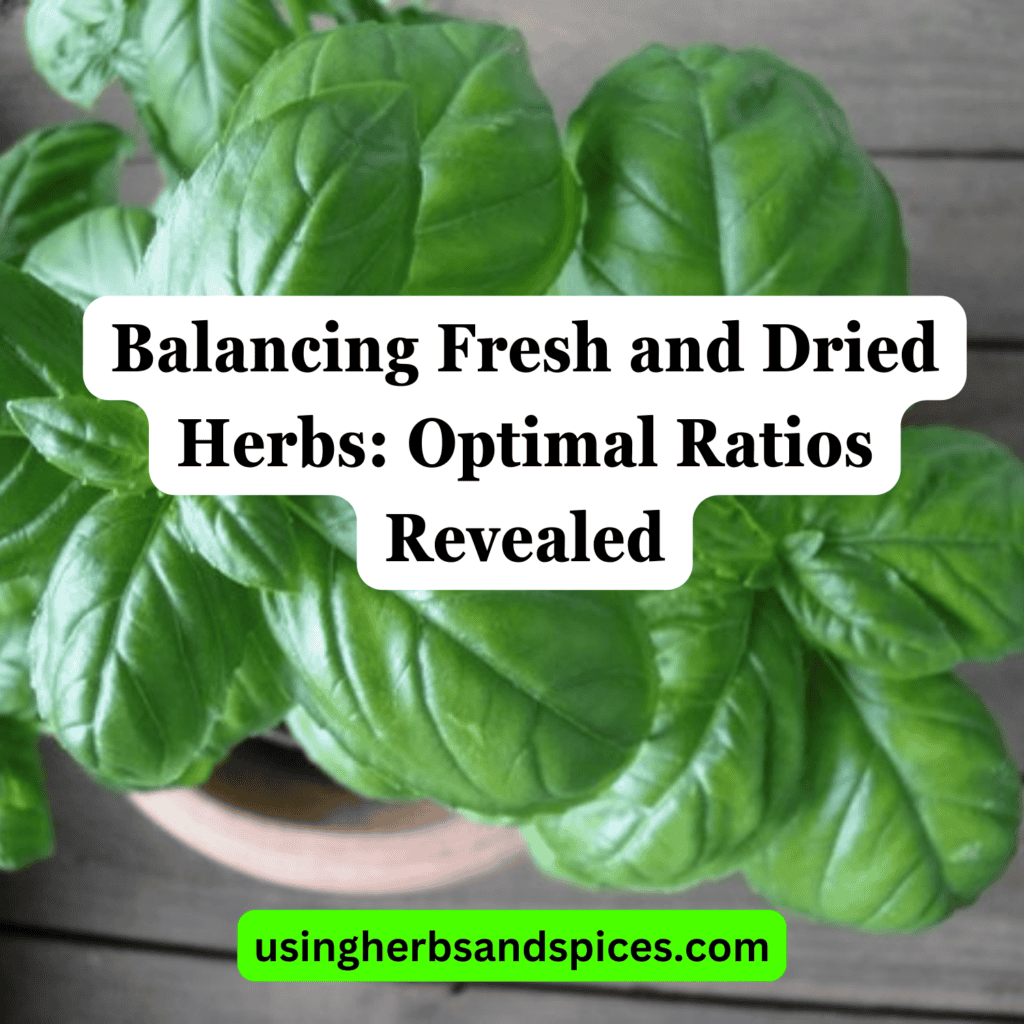Did you know that nearly 75% of chefs prefer using fresh herbs over dried, yet often struggle with the perfect ratio for maximum flavor? You’re likely aware that the general rule of thumb is a 3:1 ratio of fresh to dried herbs. However, the potency and impact of herbs can greatly vary based on their storage and the method of cooking you choose. If you’ve ever wondered why your dishes don’t quite hit that flavor sweet spot, understanding how to adjust these ratios and when to use each type of herb could be the key. Let’s explore the nuances that can elevate your cooking from good to gourmet.

Key Takeaways
- The ideal ratio for substituting fresh herbs with dried ones is 3:1.
- Dried herbs offer concentrated flavors due to moisture loss, making them potent.
- Proper storage of dried herbs is crucial for maintaining their potency over time.
- Environmental factors like soil, sunlight, and water significantly affect the aromatic strength of herbs.
- Adjusting herb ratios in recipes depends on cooking methods and the specific herb’s characteristics.
Understanding Herb Potency
To understand the essence of herb potency, it’s important to recognize that the concentration of essential oils varies greatly between fresh and dried herbs. This variation isn’t random but deeply ingrained in the herb cultivation process and the intrinsic potency factors at play. When you explore herb cultivation, it becomes obvious that environmental conditions such as soil quality, sunlight exposure, and water availability have a profound impact on the essential oil content of herbs. These conditions determine the herb’s aromatic strength and, consequently, its potency.
Moreover, potency factors aren’t static; they evolve from the moment of harvesting through the drying process. Fresh herbs, with their moisture content intact, offer a milder flavor compared to their dried counterparts. This is because drying concentrates the essential oils, thereby enhancing the herb’s flavor and aroma. However, the process of drying must be carefully managed. Too much heat or prolonged exposure can degrade the essential oils, reducing the herb’s potency.
As a member of the community passionate about culinary or medicinal herb use, understanding these nuances helps you appreciate the complexity of herb potency. It empowers you to make informed decisions in herb cultivation and usage, fostering a sense of belonging in a community that values precision and technical knowledge in its pursuits.
General Fresh to Dried Ratios
Understanding the general ideal fresh to dried herb ratios is essential for accurately translating recipes and ensuring the desired flavor intensity in your dishes. Typically, the ratio stands at 3:1, meaning for every three parts of fresh herb, you’d use one part of its dried counterpart. This ratio is crucial, considering the concentration of flavors in dried herbs due to the moisture being removed during the drying process.
Herb storage plays a significant role in maintaining these ratios. Properly stored dried herbs retain their potency for longer, ensuring that the 3:1 ratio holds true across recipes. Conversely, fresh herbs, with their limited shelf life, demand consideration of seasonal availability. This availability can influence your choice between fresh and dried herbs, pushing you to adapt based on what’s accessible while still aiming for the ideal balance in flavor.
Understanding these ratios and how herb storage and seasonal availability impact your choices allows you to navigate recipe adaptations confidently. It’s about belonging to a community that values precision in culinary arts, ensuring that every dish, regardless of the season or storage conditions, meets the high standards of flavor and quality we all cherish.
Adjusting Ratios for Cooking
Given the importance of the 3:1 fresh to dried herb ratio for flavor accuracy, it’s vital to ponder how cooking methods might necessitate adjustments to these proportions. You’re part of a community that values the subtleties of culinary expertise, and understanding the interplay between herb storage and temperature effects is key to mastering these adjustments.
Herb storage greatly influences potency. Fresh herbs stored for extended periods may lose some of their vibrancy, potentially narrowing the gap between fresh and dried ratios. Conversely, properly stored dried herbs maintain their potency over time, but exposure to heat, light, or moisture can diminish their flavor, affecting how much you’ll need to use.
Temperature effects are equally critical. High-heat cooking methods can cause fresh herbs to lose their nuanced flavors quicker than dried ones, which have already undergone a process to concentrate their flavors. In such cases, you might find that adjusting the ratio in favor of slightly more dried herbs can compensate for flavor loss during cooking.
As you refine your culinary skills, remember, these guidelines aren’t rigid rules but starting points. Your palate is the ultimate judge, and adjusting ratios to suit it’s both an art and a science.
Special Considerations for Specific Herbs
Frequently, specific herbs demand unique considerations due to their distinct flavor profiles and degradation rates when shifting from fresh to dried forms. You’re part of a community that values the precision in culinary arts, and understanding these nuances is vital for achieving the perfect balance in your dishes. Let’s explore the technical aspects and analyze how herb storage and climate impact play pivotal roles.
| Herb | Storage Consideration | Climate Impact |
|---|---|---|
| Basil | Highly sensitive to cold; prefers dry | Loses aroma quickly in heat |
| Thyme | Less sensitive; prefers cool, dark areas | Stable; drought-resistant |
| Rosemary | Requires airflow to prevent mold | Tolerates hot, dry climates |
| Cilantro | Best stored in water, refrigerated | Wilt rapidly in hot conditions |
These specific considerations highlight the importance of understanding each herb’s unique needs when moving from fresh to dried. For instance, basil’s sensitivity to cold and its rapid loss of aroma in heat necessitate careful handling and quick usage. Conversely, thyme’s resilience makes it a more forgiving herb, with a stable shift from fresh to dried. Recognizing these distinctions ensures you’re equipped to maintain the essence of your herbs, regardless of external conditions, fostering a deeper connection to your culinary creations.
Preserving Flavor and Aroma
To perfectly preserve the flavor and aroma of herbs, you must carefully consider the method and timing of their shift from fresh to dried. Identifying best storage solutions plays a vital role in this change, with each herb demanding a unique approach to maintain its essence. You’re exploring a terrain where precision meets practice, ensuring that the vibrant characteristics of each herb are locked in through meticulous drying and storage processes.
Climate impact, often overlooked, greatly influences the preservation quality. You’ll find that humidity and temperature variations can either enhance or degrade the essential oils that carry the herbs’ flavors and aromas. Therefore, adapting storage solutions to your specific climate conditions isn’t just recommended; it’s essential for anyone aiming to master the art of herb preservation.
As you delve deeper into this craft, you’ll discover that the technical aspects of preserving flavor and aroma aren’t just about following steps but about immersing yourself in a communal tradition of culinary excellence. Through understanding the delicate balance of air, moisture, and timing, you’re not just preserving herbs; you’re ensuring that the essence of your dishes remains vibrant, inviting a sense of belonging at every meal.
Frequently Asked Questions
Can I Substitute Herbs With Spices?
You can substitute herbs with spices, focusing on herb-spice compatibility to guarantee flavors blend well. Employing spice selection strategies helps in choosing the right match, promoting a sense of belonging through shared culinary experiences.
How Do Herb Allergies Affect Cooking?
When you’re dealing with herb allergies, finding allergy-friendly alternatives becomes essential. Cooking without herbs requires creativity, using spices or other flavorings to achieve a similar taste profile, ensuring you still feel included in culinary experiences.
Are All Dried Herbs More Potent Than Fresh?
Yes, you’re exploring the culinary world where dried herbs often pack a punch above their weight compared to fresh. In the domain of herb preservation and culinary experimentation, this potency is a beacon for flavorful dishes.
Is There a Herb Drying Process for Beginners?
Yes, there’s a beginner-friendly herb drying process. Start with careful herb selection, focusing on freshness and quality. Then, explore simple drying techniques, like air drying or using a dehydrator, to preserve their essence perfectly.
Do Herb Flavors Change Over Time When Stored?
Time waits for no one, and that’s true for herb flavors too. You’ll find flavor degradation concerns central in herb preservation methods. Storing them properly slows this process, ensuring you’re part of a community valuing taste.
Tribute to the art of Seasoning
To conclude, mastering the balance between fresh and dried herbs hinges on the 3:1 ratio, adept storage, and tailored adjustments for cooking methods.
Consider basil, for instance. When substituting dried for fresh in a pesto, the potency disparity demands precision—less is more. This analytical approach guarantees flavors remain vibrant, not overwhelming.
By dissecting herb characteristics and optimizing their use, you’ll preserve the essence of your dishes, making each culinary creation a tribute to the art of seasoning.
